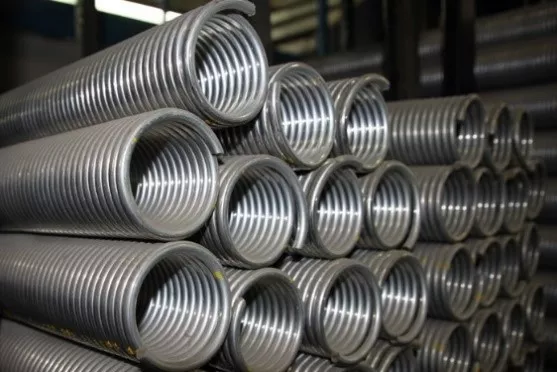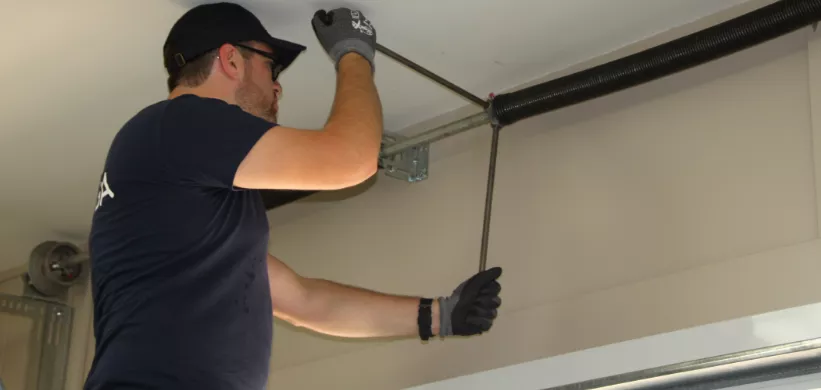Torsion springs are used in all kinds of ways as functioning components in things we come in contact with every day. One place torsion springs can be found in your home is as a part of your garage door opener. These springs function within a system that works to counterbalance your garage door’s weight so that it can be easily lifted and lowered in a safe manner.
Now, it’s not likely that you’re looking to be an expert on torsion springs and how they fit into the system that opens your garage door, but it’s important for you to know a little something about them if you have them in your garage.

Benefits of torsion springs in a garage door opener
There are two types of springs that are used in garage door openers. Extension springs work within a system where the springs are located above tracks that run across the ceiling. Torsion springs are installed right over the top of the door.
Torsion springs are more popular for a few different reasons. They provide these benefits:
- Less noise—As the springs are not attached to the ceiling, there is less noise transferred through to any room that may be above the garage. Also, the springs are inserted inside a shaft that is securely anchored in place. This cuts down on vibrations that can be very noisy.
- Safer—Sometimes things break. If the torsion spring should break, it’s inside of a housing that will catch any pieces that could fall and damage cars or other things that are stored in your garage.
- Smoother functioning—Torsion springs work to balance all of the weight of the garage door to the center. In an extension system, there are two springs that work independently of each other to pull the door up from their positions over each track. This can cause shaking and wobbling because of a lack of balance. Torsion spring systems won’t have that same shaking during opening and closing because of the centralized balance.
How torsion spring systems work
Most of us have seen a torsion spring, even if maybe we weren’t aware of what it was. It looks like a tightly wound coil. To power movement, the spring uses a twisting motion to store or release mechanical energy. The release of tension when the door is being opened and the increase in tension when the door is being closed serves the door in the same way the counterweights did in the days of old.
The torsion spring is part of a functioning system
The spring itself can’t do the whole job on its own. There are other parts that work along with the spring to create the movement that allows you to easily open and close your garage door. The actual spring is placed into a shaft that houses it and has an anchor plate so you can securely mount it to the wall. There is also a lifting cable that runs down the door and is secured at the bottom by a bracket that holds it in place. Finally, there is the grooved drum that winds and unwinds the lifting cable accordingly. If one of these components isn’t working properly, you may need a professional to come and fix it. You need everything, bottom bracket + lifting cable + drum + shaft + spring, to be functioning right to keep your opener performing reliably.
For informational purposes, let’s look at how much your garage door might weigh. Keeping in mind that materials vary sometimes and that these weights are just a guideline.
- For a 1 ¾"‑thick steel door (insulated with polyurethane foam): about 2 lb. per square foot
- 9 x 7 ft. (Single)= around 150 to 160 lb. (68 to 73 kg)
- 16 x 7 ft. (Double)= around 280 to 295 lb. (127 to 135 kg)
- For a 2"‑thick steel door (non‑insulated): about 1 ½ lb. per square foot
- 9 x 7 ft. (Single)= around 125 to 130 lb. (57 to 59 kg)
- 16 x 7 ft. (Double)= around 280 to 295 lb. (102 to 107 kg)
Additional information
This is additional information that is based off of questions we frequently get from our customers:
-
Looking out of a single door garage, will the spring always be installed on the left?
No. The spring can be placed on either side of the door. The door will function properly regardless of the spring placement.
-
Do I need one or two springs?
Generally, you’ll find that single doors have one spring and double doors have two.
-
What’s the useful life of a spring?
Springs are rated for how many cycles (cycle = opening + closing) they are expected to last for. The average garage door opener spring is rated for 10,000 cycles. If you use your garage door like an average user does, cycling it two or three times a day, then your springs should last about seven years. If your household cycles your garage door more heavily, you can find springs that are rated for more cycles.
-
Will the springs rust?
Your springs can rust. They are usually, at least, partially galvanized. Most springs have anywhere from 35‑40% of zinc contained in them to keep them from rusting. If you need fully galvanized torsion springs because of the area you live in, those are available also.
-
How can I make my springs last longer?
Regular lubricating is recommended for all of the metal parts that move as a part of your garage door opener system. You need to put a little oil on the metal rollers, the hinges, and the springs about twice a year. This will keep the parts in better condition and help to cut down on noise.
-
How can I test my garage door opener system?
Turn the opener off. Then try to open the garage door with one hand. It shouldn’t take much effort to get it to open. The weight should feel no heavier than 10 lbs. If you find that you’re having to strain to get it open, something isn’t right, so you should call a specialist to find out what it is.
-
Does a torsion spring have to be mounted in the front of the garage?
No. There has to be enough room above the door (12” approximately) to mount the spring over it in the front. If there’s not, then sometimes the spring gets attached to the rear side of the garage. When this is the case, a set of horizontal tracks will have to be added also.
Spring repairs should be handled by an expert
If you find you’re in need of a spring repair, don’t try to fix it yourself. It can be very dangerous for someone who isn’t familiar with how to make this kind of repair. If you live in or around Ottawa, let us fix it for you. Contact us now at 1-613-749-2138. We know what it takes to repair these parts that are under high tension. Let us send you a quotation by email if your springs need any kind of maintenance.



Add new comment